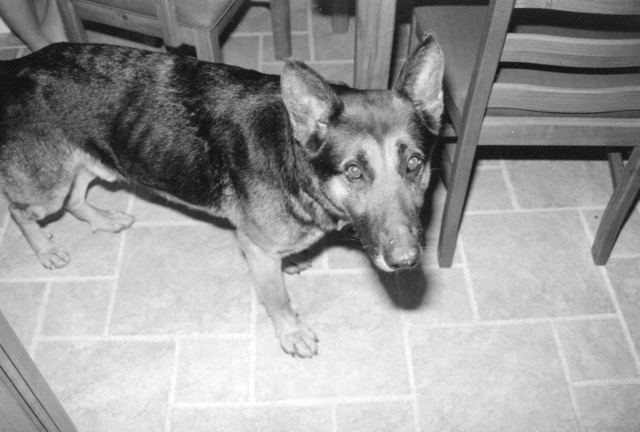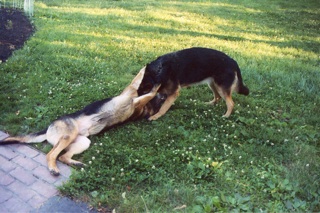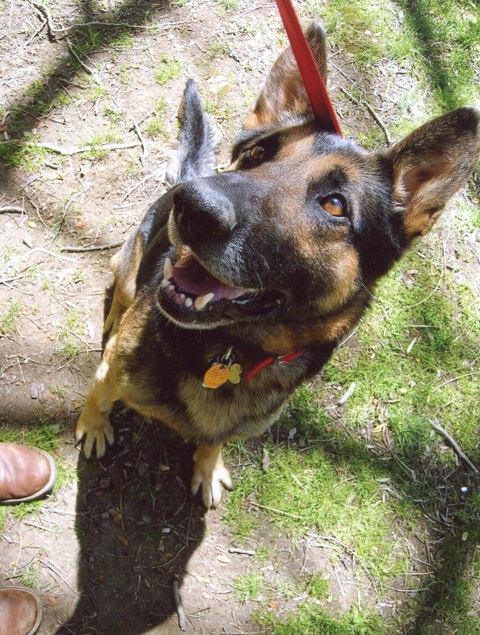by Rick Snyder, GSR-SP volunteer & foster dad
Our family had been in contact with GSR-SP for years, first adopting a German Shepherd through them, then volunteering at events, and then adopting another. We wanted to do more, though, and after hearing about a shortage of foster homes, we decided that this was an important way we could help the organization. It seemed so painfully unjust, to think of the clock relentlessly ticking away on a good dog in a crowded shelter with nowhere to go, and we wanted to help.

We also knew it would be a serious undertaking, with time spent training and evaluating and getting used to another dog in the mix at home. Still, when word came that there was a dog to be fostered, we were nervous and excited to give this thing a try.
Major was a male German Shepherd dog, anywhere from 3-5 years of age, who was at a shelter in central PA. He had been evaluated there by a volunteer, who through experience had determined that he was a good dog who’d just had some tough breaks.
Major had been a yard dog. He’d spent his 3-5 years on a concrete pad, chained to a doghouse, in someone’s backyard. When the person moved, they left Major behind. A neighbor eventually noticed he was unattended, and called the SPCA.
Major was skinny. He had rope burns around his neck. His hind legs were under-developed from lack of exercise. He had some pressure sores from the concrete pad.
We drove out to see him, figuring that if he got along with our other Shepherd, Maggie, we’d take him on. We brought Maggie along, thinking we’d get them to interact a bit and see how it went.
When we arrived at the shelter, we found that the staff had brought him into the main lobby area, and put him in their greeting enclosure there. Major was being what we call a popcorn dog, in that he was bouncing up and down like popcorn in a pan, and barking his fool head off at the prospect of someone coming to pay him some attention. His head would appear and dissappear and reappear, up and down and up and down, bark bark bark bark bark.
We managed to put a lead on him, and took him to the shelter’s grassy patio area, where you could go to get a look at the dogs and walk them around. Major sniffed around the grass, peed on a bush, and sniffed at us and at Maggie. He seemed friendly enough. Maggie was nervous and excited to meet him, but when he tried to mount her she let him have some bared teeth and a big snarl, and we pulled them apart. When we let them back together again, Major was more subdued. In all the time we had him, he never did that again. We gave them some more time together, saw that they had sorted out their first doggie issue well enough, went back inside and filled out the paperwork and gave them the check. Major was now our responsibility.
In one way, we were lucky. With Major, we knew what his story was, where he had lived and what he had been through. A lot of dogs come to us with very little information, or none at all. In another way, Major was a very challenging dog. He was essentially a gigantic overgrown puppy, with no house training and no socialization of any kind.

Things Major did included climbing over the sofa and into the big picture window, knocking over plant pots and spilling dirt all over, so he could stand and lean against the front windows and greet us when we came up the walk. We temporarily relocated the plants, and told him not to do that.
He lifted his leg in the house. Once. He got the spray bottle for that, and a sharp no.
He chased our old cat. Once. We tugged his leash and told him no.
We took him to the vet, and he behaved himself just fine.
And so on, and so on. We tried to be firm but kind, because we remembered he’d never been in a house, maybe had never been let near a cat, and he couldn’t know right from wrong until we taught him.
And Major was a quick learner. Pretty much tell him once, and he got it.
Things Major did not do included playing. You could throw a ball or a frisbee, and he’d look at it. Maggie would come up and give him her “Let’s play” bow, and he’d just look at her, and then look at us for direction. We never really got him to play with toys or fetch us anything, but Maggie refused to give up on the playing, and pestered and rassled and chewed on him enough that he finally started getting the hang of it.
We let him settle in for a few weeks, and get comfortable enough to show us his true colors. The volunteer had been right. Good dog, bad breaks. Now he was getting along with us, with strangers, with other dogs, and he was leaving the cats alone. No messing in the house, no fighting over food, no big problems.
So after a month, we talked it over with our rescue friends, and they put him up on the website.
There was very little interest in Major.
In a shelter, with limited capacity, overworked staff and no one to teach him, that would have spelled disaster. In our home, Major was just passing the time, hanging out, learning how to leash walk and race around the yard.
A couple months went by. We’d just about come to the conclusion that Major was a permanent addition to our home, when we were told there was someone who might be interested in adopting him. We got the contact information, and did the proper introductions. Major behaved just fine with the other dogs in his prospective home, and enjoyed having attention lavished on him by his potential new parents. He ended up being adopted by a wonderful family, and lived happily ever after.

We know, because we still go to visit him every now and then. I’m not sure if he still remembers us, or his hard life before we took him in. But if there’s any place on earth that’s the exact opposite of a doghouse on a concrete pad, this place is it; Major’s forever home is wonderful, and he’s got it really good.
He’s not our dog. We didn’t even have him for that long. But I’m so happy we were there for him when he needed to catch a break. And to know that all the work we put in, to try and set him up as best we could to be a good dog for someone else, paid off so well.
